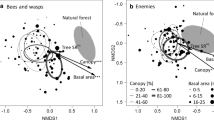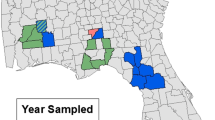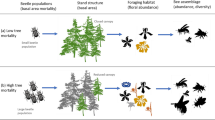Abstract
Disturbances associated with intensive agriculture facilitate the spread of invasive plants that become dominant along habitat edges in fragmented landscapes. Many invasive woody plants offer large quantities of floral resources to bees, but little is known about how invasive plants affect the use of flowering resources in the forest canopy and understory by native bee communities. We sampled the bee community at vertical strata along forest-agriculture edges that varied in density of a dominant invasive shrub Lonicera maackii before, during, and after the flowering period. We also recorded diameters and species identities of woody stems. Bee and woody plant abundance, diversity, and life-history traits were then spatially and temporally compared in response to L. maackii density. Overall, we found that L. maackii structured bee communities through its floral resources by altering bee species composition and supporting greater abundances and species richness of bees during and after its flowering period. We also demonstrated a diverse and abundant bee community up to 16 m high in the forest canopy that is supported by floral resources of native shrubs and trees but sensitive to woody shrub invasion. These findings collectively suggest that this invasive shrub structures the bee community in favor of species that use its own flowers and competes with co-flowering woody species at different vertical strata. Our study emphasizes the importance of forest trees and shrubs for bees in agricultural landscapes and demonstrates potential risks for early-season bees as well as those that cannot use floral resources of this invasive shrub.





Similar content being viewed by others
References
Abbott HG (1974) Some characteristics of fruitfulness and seed germination in red maple. Tree Planters’ Notes 25(2):25–27
Aizen MA, Morales CL, Morales JM (2008) Invasive mutualists erode native pollination webs. PLoS Biol 6:e31
Ascher JS, Pickering J (2018) Discover Life bee species guide and world checklist (Hymenoptera: Apoidea: Anthophila). Accessed 10 Feb 2019. http://www.discoverlife.org/mp/20q?guide=Apoidea_species
Barriball K, Goodell K, Rocha OJ (2014) Mating patterns and pollinator communities of the invasive shrub Lonicera maackii: a comparison between interior plants and edge plants. Int J Plant Sci 175(8):946–954
Bartomeus I, Ascher JS, Gibbs J, Danforth BN, Wagner DL, Hedtke SM, Winfree R (2013) Historical changes in northeastern US bee pollinators related to shared ecological traits. PNAS 110(12):4656–4660
Bartuszevige AM, Gorchov DL (2006) Avian seed dispersal of an invasive shrub. Biol Invasions 8:1013–1022
Batra SWT (1985) Red Maple (Acer rubrum L.), an important early spring food resource for honey bees and other insects. J Kansas Entomol Soc 58(1):169–172
Bertrand C, Eckerter PW, Ammann L, Entling MH, Gobet E, Herzog F, Mestre L, Tinner W, Albrecht M (2019) Seasonal shifts and complementary use of pollen sources by two bees, a lacewing and a ladybeetle species in European agricultural landscapes. J Appl Ecol 00:1–12
Brooks ME, Kristensen K, Benthem KJ, Magnusson A, Berg CW, Nielsen A, Skaug JH, Maechler M, Bolker BM (2017) glmmTMB balances speed and flexibility among packages for zero-inflated generalized linear mixed modeling. R J 9(2):378–400
Burkle LA, Marlin JC, Knight TM (2013) Plant-pollinator interactions over 120 years: loss of species, co-occurrence, and function. Science 339:1611
Burns RM, Honkala BH (Technical coordinators) (1990) Silvics of North America, vol 2. Hardwoods. U.S. Department of Agriculture, Forest Service, Agriculture Handbook 654, 1711 p
Cane JH, Griswold T, Parker F (2007) Substrates and materials used for nesting by North American Osmia bbes (Hymenoptera: Apiformes: Megachilidae). Ann Entomol Soc Am 100(3):350–358
Carvalheiro LG, Biesmeijer JC, Benadi G, Fründ J, Stang M, Bartomeus I, Kaiser-Bunbury CN, Baude M, Gomes SIF, Merckx V, Baldock KCR, Bennett ATD, Boada R, Bommarco R, Cartar R, Chacoff N, Dänhardt J, Dicks LV, Dormann CF, Ekroos J, Henson KSE, Holzschuh A, Junker RR, Lopezaraiza-Mikel M, Memmott J, Montero-Castaño A, Nelson IL, Petanidou T, Power EF, Rundlöf M, Smith HG, Stout JC, Temitope K, Tscharntke T, Tscheulin T, Vilá M, Kunin WE (2014) The potential for indirect effects between co-flowering plants via shared pollinators depends on resource abundance, accessibility and relatedness. Ecol Lett 17:1389–1399
Chambers VH (1945) British bees and wind-borne pollen. Nature 155:145
Christopher CC, Matter SF, Cameron GN (2014) Individual and interactive effects of Amur honeysuckle (Lonicera maackii) and white-tailed deer (Odocoileus virginianus) on herb communities in deciduous forests in the eastern United States. Bio Invasions 16(11):2247–2261
Collier MH, Vankat JL, Hughes MR (2002) Diminished plant richness and abundance below Lonicera maackii, an invasive shrub. Am Midl Nat 147:60–71
Cunningham-Minnick MJ, Peters VE, Crist TO (2020) Bee communities and pollination services in adjacent crop fields following flower removals in an invasive forest shrub. Ecol Appl. https://doi.org/10.1002/eap.2078
Dolédec S, Chessel D, Braak CJF, Champely S (1996) Matching species traits to environmental variables: a new three-table ordination method. Environ Ecol Stat 3(2):143–166
Dray S, Dufour AB (2007) The ade4 package: implementing the duality diagram for ecologists. J Stat Softw 22(4):1–20
Dray S, Legendre P (2008) Testing the species traits-environment relationships: the fourth-corner problem revisited. Ecology 89(1):3400–3412
Feret PP, Kreh RE, Merkle SA, Oderwald RG (1982) Flower abundance, premature acorn abscission, and acorn production in Quercus alba L. Bot Gaz 143(2):216–218
Fossen T, Holmelid B, Ovstedal DO (2019) Bumblebee death associated with Tilia europaea L. Biochem Syst Ecol 82:16–23
Gabriel WJ, Garrett PW (1984) Pollen vectors in sugar maple (Acer saccharum). Can J Bot 62:2889–2990
Geroff RK, Gibbs J, McCravy KW (2014) Assessing bee (Hymenoptera: Apoidea) diversity of an Illinois restored tallgrass prairie: methodology and conservation considerations. J Insect Conserv 18(951):964
Gibbs J (2010) Revision of the metallic species of Lasioglossum (Dialictus) in Canada (Hymenoptera, Halictidae, Halictini). Zootaxa 2591:1–382
Gibbs J, Packer L, Dumesh S, Danforth BN (2013) Revision and reclassification of Lasioglossum (Evylaeus), L. (Hemihalictus) and L. (Sphecodogastra) in eastern North America (Hymenoptera: Apoidea: Halictidae). Zootaxa 3672:1–117
Gibbs J, Joshi NK, Wilson JK, Rothwell NL, Powers K, Haas M, Gut L, Biddinger DJ, Isaacs R (2017) Does passive sampling accurately reflect the bee (Apoidea: Anthophila) communities pollinating apple and sour cherry orchards? Environ Entomol 46(3):579–588
Goodell K, McKinney AM, Lin CH (2010) Pollen limitation and local habitat-dependent pollinator interactions in the invasive shrub Lonicera maackii. Int J Plant Sci 171(1):63–72
Grisez TJ (1975) Flowering and seed production in seven hardwood species. United States Department of Agriculture Forest Service Research Paper, Northeastern Forest Experiment Station, NE-315
Hassett MR, McGee GG (2017) Negative binomial hurdle models to estimate flower production for native and nonnative Northeastern shrub taxa. Forest Sci 63(6):577–585
Hoehn P, Tscharntke T, Tylianakis JM, Steffan-Dewenter I (2008) Functional group diversity of bee pollinators increases crop yield. Proc R Soc B 275:2283–2291
Hoven BM, Gorchov DL, Knight KS, Peters VE (2017) The effect of emerald ash borer-caused tree mortality on the invasive shrub Amur honeysuckle and their combined effects on tree and shrub seedlings. Biol Invasions 19:2813–2836
Jachuła J, Denisow B, Strzałkowska-Abramek M (2019) Floral reward and insect visitors in six ornamental Lonicera species—plant suitable for urban bee-friendly gardens. Urban For Urban Gree 44:126390
Jacquemart A, Moquet L, Ouvrard P, Quetin-Leclercq J, Herent MF, Quinet M (2018) Tilia trees: toxic or valuable resources for pollinators? Apidologie 49(5):538–550
Joshi NK, Leslie T, Rajotte EG, Kammerer MA, Otienno M, Biddinger DJ (2015) Comparative trapping efficiency to characterize bee abundance, diversity, and community composition in apple orchards. Ann Entomol Soc Am 108(5):785–799
Klecka J, Hadrava J, Koloušková P (2018) Vertical stratification of plant-pollinator interactions in a temperate grassland. PeerJ 6:e4998
Kleijn D, Winfree R, Bartomeus I, Carvalheiro LG, Henry M, Isaacs R, Klein AM, Kremen C, M’Gonigle LK, Rader R, Ricketts TH, Williams NM, Adamson NL, Ascher JS, Báldi A, Batáry P, Benjamin F, Biesmeijer JC, Blitzer EJ, Bommarco R, Brand MR, Bretagnolle V, Button L, Cariveau DP, Chifflet R, Colville JF, Danforth BN, Elle E, Garratt MPD, Herzog F, Holzschuh A, Howlett BG, Jauker F, Jha S, Knop E, Krewenka KM, Féon VL, Mandelik Y, May EA, Park MG, Pisanty G, Reemer M, Riedinger V, Rollin O, Rundlöf M, Sardiñas HS, Scheper J, Sciligo AR, Smith HG, Steffan-Dewenter I, Thorp R, Tscharntke T, Verhulst J, Viana BF, Vaissiére BE, Veldtman R, Westphal C, Potts SG (2015) Delivery of crop pollination services is an insufficient argument for wild pollinator conservation. Nat Comm 6:7414
Koch H, Stevenson PC (2017) Do linden trees kill bees? Reviewing the causes of bee deaths on silver linden (Tilia tomentosa). Biol Letters 13:20170484
Laska MS, Stiles EW (1994) Effects of fruit crop size on intensity of fruit removal in Viburnum prunifolium (Caprifoliaceae). Oikos 69(2):199–202
Lüdecke D, Makowski D, Waggoner P (2019) performance: assessment of regression models performance. R package version 0.4.0. https://CRAN.R-project.org/package=performance
Macior LW (1978) Pollination ecology of vernal angiosperms. Oikos 30(3):452–460
McCarthy BC, Quinn JA (1989) Within- and among-tree variation in flower and fruit production in two species of Carya (Juglandaceae). Am J Bot 76(7):1015–1023
McKinney AM, Goodell K (2010) Shading by invasive shrub reduces seed production and pollinator services in a native herb. Biol Invasions 12:2751–2763
McNeish RE, McEwan RW (2016) A review on the invasion ecology of Amur honeysuckle (Lonicera maackii, Caprifoliaceae) a case study of ecological impacts at multiple scales. J Torrey Bot Soc 143(4):367–385
Michener CD (2000) The bees of the world, vol 26, 2nd edn. The Johns Hopkins University Press, Baltimore, pp 708–709
Miller KE, Gorchov DL (2004) The invasive shrub, Lonicera maackii, reduces growth and fecundity of perennial forest herbs. Oecologia 139:359–375
Montero-Castaño A, Vilá M (2012) Impact of landscape alteration and invasions on pollinators: a meta-analysis. J Ecol 100:884–893
Morales CL, Traveset A (2009) A meta-analysis of impacts of alien vs native plants on pollinator visitation and reproductive success of co-flowering native plants. Ecol Lett 12:716–728
Nuttman CV, Otieno M, Kwapong PK, Combey R, Willmer P, Potts SG (2011) The utility of aerial pan-trapping for assessing insect pollinators across vertical strata. J Kansas Entomol Soc 84(4):260–270
Okansen J, Blanchet FG, Friendly M, Kindt R, Legendre P, McGlinn D, Minchin PR, O’Hara RB, Simpson GL, Solymos P, Stevens MHH, Szoecs E, Wagner H (2019) Vegan: community ecology package. R package version 2.5-5
Parker GR, Leopold DJ, Eichenberger JK (1985) Tree dynamics in an old-growth, deciduous forest. Forest Ecol Manag 11:31–57
Proesmans W, Smagghe G, Meeus I, Bonte D, Verheyen K (2019) The effect of mass-flowering orchards and semi-natural habitat on bumblebee colony performance. Landsc Ecol 34:1033–1044
R Core Team (2018) R: a language and environment for statistical computing. R Foundation for Statistical Computing, Vienna, Austria. https://www.R-project.org/
Rhoades PR (2010) Four aspects of dogwood pollination: insect visitation, a novel approach to identify pollen, floral volatile emission, and tracking parentage. (Masters Thesis) Retrieved from The University of Tennessee TRACE
Rhoades P, Griswold T, Waits L, Bosque-Pérez NA, Kennedy CM, Eigenbrode SD (2017) Sampling technique affects detection of habitat factors influencing wild bee communities. J Insect Conserv 21:703–714
Richards MH, Rutgers-Kelly A, Gibbs J, Vickruck JL, Rehan SM, Sheffield CS (2011) Bee diversity in naturalizing patches of Carolinian grasslands in southern Ontario, Canada. Can Entomol 143:279–299
Robertson C (1929) Flowers and insects; lists of visitors of four hundred and fifty-three flowers. Carlinville, Ill, p 221
Roubik DW (1993) Tropical pollinators in the canopy and understory: field data and theory for stratum “preferences”. J Insect Behav 6(6):659–673
Saunders ME (2018) Insect pollinators collect pollen from wind-pollinated plants: implications for pollination ecology and sustainable agriculture. Insect Conserv Diver 11:13–31
Smith C, Weinman L, Gibbs J, Winfree R (2019) Specialist foragers in forest bee communities are small, social or emerge early. J Anim Ecol 88:1158–1167
Sobek S, Tscharntke T, Scherber C, Schiele S, Steffan-Dewenter I (2009) Canopy vs. understory: Does tree diversity affect bee and wasp communities and their natural enemies across forest strata? Forest Ecol Manag 258:609–615
Somme L, Moquet L, Quinet M, Vanderplanck M, Michez D, Lognay G, Jacquemart A (2016) Food in a row: urban trees offer valuable floral resources to pollinating insects. Urban Ecosyst 19:1149–1161
Southwick EE, Loper GM, Sadwick SE (1981) Nectar production, composition, energetics and pollinator attractiveness in spring flowers of western New York. Am J Bot 68(7):994–1002
Stangler ES, Hanson PE, Steffan-Dewenter I (2016) Vertical diversity patterns and biotic interactions of trap-nesting bees along a fragmentation gradient of small secondary rainforest remnants. Apidologie 47:527–538
Stout JC, Tiedeken EJ (2017) Direct interactions between invasive plants and native pollinators: evidence, impacts and approaches. Funct Ecol 31:38–46
Tucker SK, Ginsberg HS, Alm SR (2019) Eastern carpenter bee (Hymenoptera: Apidae): Nest structure, nest cell provisions, and trap nest acceptance in Rhode Island. Environ Entomol 48(3):702–710
Tuell JK, Isaacs R (2009) Elevated pan traps to monitor bees in flowering crop canopies. Entomol Exp Appl 131:93–98
Ulyshen MD, Soon V, Hanula JL (2010) On the vertical distribution of bees in a temperate deciduous forest. Insect Conserv Diver 3:222–228
U.S. Department of Agriculture, Forest Service (2008) The woody plant seed manual. U.S. Department of Agriculture, Agriculture Handbook 727, Washington D.C. 1228 p
Vanbergen AJ, Espíndola A, Aizen MA (2017) Risks to pollinators and pollination from invasive alien species. Nat Ecol Evol 2:16–25
Vilà M, Bartomeus I, Dietzsch AC, Petanidou T, Steffan-Dewenter I, Stout JC, Tscheulin T (2009) Invasive plant integration into native plant-pollinator networks across Europe. Proc R Soc B 276:3887–3893
Weiskittel A, Kuehne C, McTague JP, Oppenheimer M (2016) Development and evaluation of an individual tree growth and yield model for the mixed species forest of the Adirondacks Region of New York, USA. For Ecosyst 3:26
Wickham H (2016) ggplot2: Elegant graphics for data analysis. Springer-Verlag, New York, p 2016
Wildman RH (2008) Ohio’s forest resources, 2006. Note. NRS-22 U.S. Department of Agriculture, Forest Service, Northern Research Station. Newton Square, PA
Williams NM, Cariveau D, Winfree R, Kremen C (2011) Bees in disturbed habitats use, but do not prefer, alien plants. Basic Appl Ecol 12:332–341
Willson MF, Schemske DW (1980) Pollinator limitation, fruit production, and floral display in pawpaw (Asimina triloba). B Torrey Bot Club 107(3):401–408
Wood TJ, Kaplan I, Szendrei Z (2018) Wild bee pollen diets reveal patterns of seasonal foraging resources for honey bees. Front Ecol Evol 6:210
Acknowledgements
We are thankful for land access and the continued support of growers and private landowners Bob Black, Bogan Elementary School staff, Gerald Bruns, Gary Kerr, Lloyd Lee, Robert Mitzel, Jan O’Connor, John Robertson, Pam Ristaneo, Tom Roell, Tom Study, Waldorf Farm LLC, Sharon Wooley, Alan Vonderhaar, and their families. We thank Kelsey Donahue, Michaela Dray, Alli Gay, Clara Moiseyeva, and Abby VanGorder for excellent technical assistance and additional gratitude towards Kelsey Donahue and Alli Gay for assistance in the field. This work would not have possible without the funding support from the Ohio Biological Survey and Miami University. Finally, we are grateful for the contributions of two anonymous reviewers in improving the quality of this manuscript.
Author information
Authors and Affiliations
Corresponding author
Additional information
Publisher's Note
Springer Nature remains neutral with regard to jurisdictional claims in published maps and institutional affiliations.
Electronic supplementary material
Below is the link to the electronic supplementary material.
Rights and permissions
About this article
Cite this article
Cunningham-Minnick, M.J., Crist, T.O. Floral resources of an invasive shrub alter native bee communities at different vertical strata in forest-edge habitat. Biol Invasions 22, 2283–2298 (2020). https://doi.org/10.1007/s10530-020-02248-y
Received:
Accepted:
Published:
Issue Date:
DOI: https://doi.org/10.1007/s10530-020-02248-y




